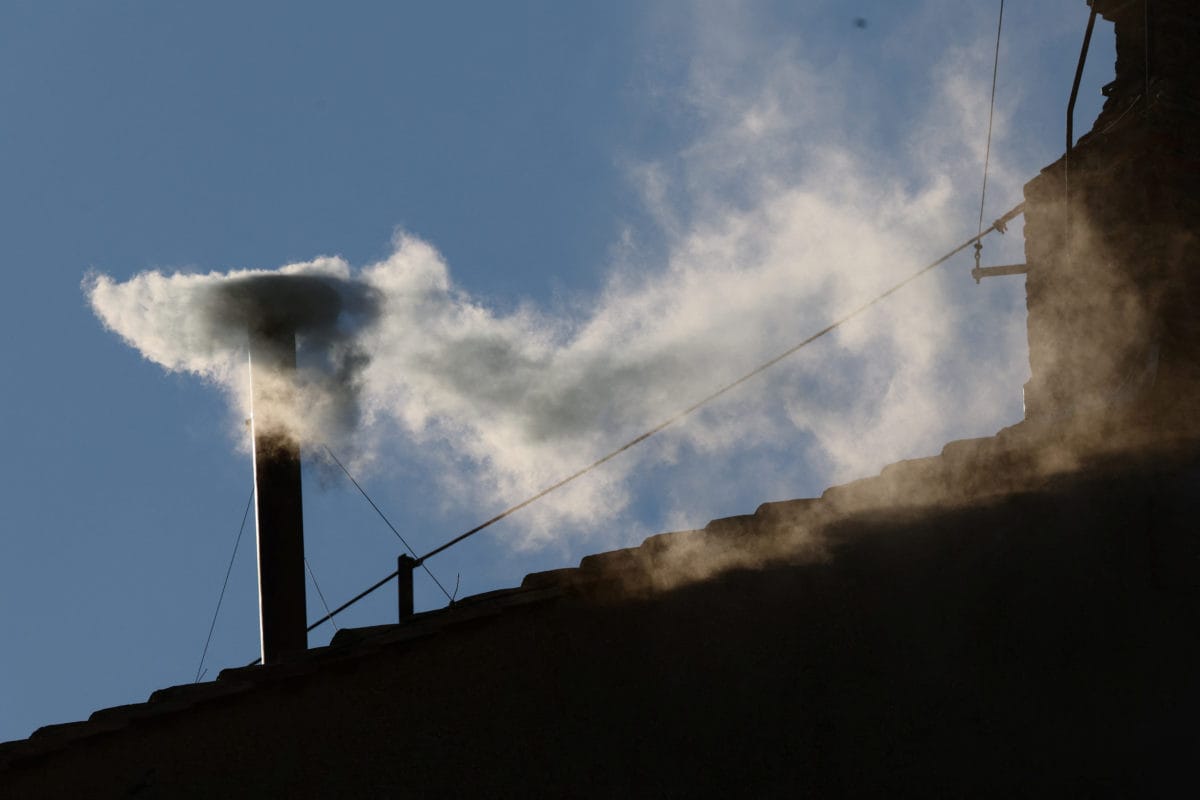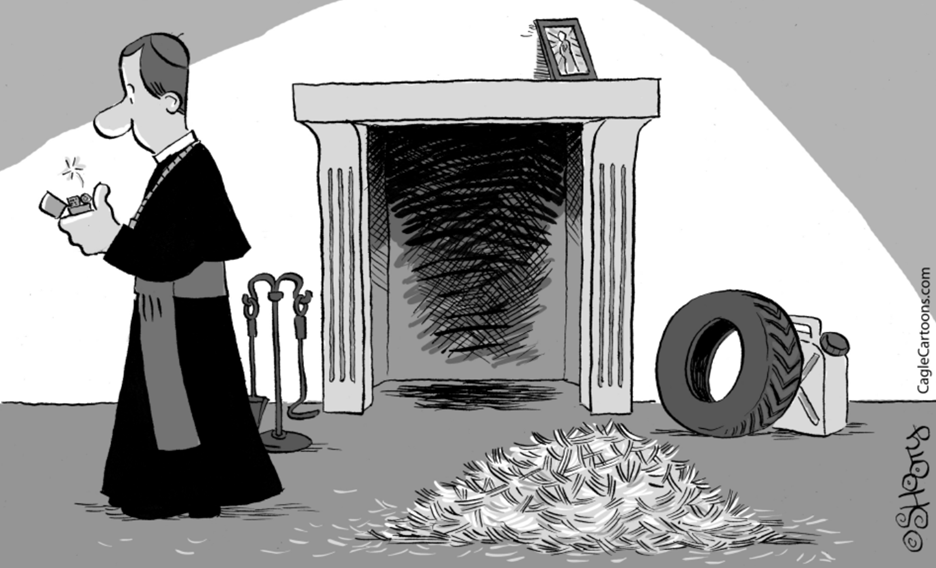Chemistry at the Papal Conclave: The Role of Chemicals in Black and White Smoke
by Ken Rock, MSDC Editor

The papal conclave is one of the most watched and visually iconic events in the Catholic Church, held when a new pope is elected. A striking feature of this centuries-old tradition is the appearance of either black or white smoke rising from the 6-foot high copper chimney fixed on the roof the Sistine Chapel.
As we saw at the recent papal conclave, these clouds of smoke serve as a visual signal to the world about the outcome of the voting process — black smoke indicating that no pope has been chosen, and white smoke confirming that a new pontiff has been elected.

While the visual spectacle is widely recognized, the underlying chemistry behind the creation of these colored smokes is less well-known. The specific chemicals used to create the dramatic effects of black and white smoke have been carefully chosen for both their visual impact and their ability to remain consistent with the historic and symbolic nature of the event.
The Papal Conclave Smoke Tradition
When a pope dies or resigns, the College of Cardinals, comprising cardinals from around the world, convenes in the Sistine Chapel within the Vatican to elect a new pope. The process is conducted with utmost secrecy, emphasizing the gravity and sanctity of the task at hand. The cardinals participate in daily ballots, voting until a candidate receives a two-thirds majority.
To ensure the integrity of the process, the ballots are burned after each voting session. This act serves a dual purpose: it prevents the possibility of tampering or posthumous scrutiny and provides a way to communicate the election's progress to the outside world.
The tradition of signaling the election of a pope with smoke has been in place since the 12th century. However, the modern use of smoke, as we know it today, began in the 1800s. Initially, the smoke was created by burning incense and other materials in the papal conclave’s hearth. The smoke was used to signal to the waiting crowd whether or not the cardinal-electors had reached a decision.
In 1903, the first use of colored smoke was introduced to make the announcement more visible and distinct. White smoke, used to indicate a new pope, became a symbol of hope and clarity, while black smoke signaled that a decision had not been reached. Over the years, the color and consistency of the smoke has varied, with results occasionally creating confusion about the result being indicated. Over time, the process has been refined, relying on chemistry to ensure that the smoke is both a reliable signal and visually striking.
The chemistry now used in the combustion process to create the white and black smoke are described in the YouTube video that may be found HERE.
Black Smoke: No Consensus
If the ballots burned after a voting session do not result in the election of a new pope, chemicals are added to the fire to produce black smoke, known as "fumatanera." This dark smoke billows from the chimney of the Sistine Chapel, signaling to the anxious observers in St. Peter's Square and beyond that no decision has been reached. The sight of black smoke can be met with sighs of disappointment and renewed anticipation as the faithful wait for the next round of voting.

White Smoke: The Signal of a New Pope
White smoke, signaling the election of a new pope, is produced by a carefully controlled mixture of chemicals that burn cleanly and efficiently, producing a dense, white cloud. This white smoke is the most anticipated of the two signals and is designed to be visible from a great distance and persistent in the sky.
Historically, the white smoke was produced by burning special types of incense, but this method was often unreliable. In 1958 and 1978, for example, crowds and media misread the smoke, mistakenly believing a pope had been elected when he hadn't. Over time, papal officials began experimenting with more predictable and effective methods. The new methods are intended to prevent such misunderstandings.

Modern Techniques
Since the 2005 conclave, which elected Pope Benedict XVI, the Vatican adopted a dual-stove system and began using chemical additives to produce more consistent and easily identifiable smoke colors. This system involved installing two stoves connected to the same chimney. The main stove, which burns the actual paper ballots after each voting session, and an auxiliary stove, which contains the chemical compounds that generate either black or white smoke. These are ignited simultaneously and the smoke from both mixes in a common pipe and wafts out of the famous chimney to produce the correct smoke color.

Chemical Additives
To improve visibility and avoid confusion, the Vatican now uses precise chemical mixtures in formulating the white smoke (indicating a new pope has been elected) and black smoke (indicating no decision yet).
Ingredients for white smoke are potassium chlorate (an oxidizer), lactose (fuel), and pine rosin (to create thick, white smoke). Ingredients for black smoke are potassium perchlorate (an oxidizer), anthracene (a hydrocarbon), and sulfur (to help the process).

The use of these chemicals ensures that the smoke is both reliable and visible from the Vatican to the thousands of spectators gathered in St. Peter's Square. These compounds have been carefully chosen to produce a smoke that is both symbolic and practical, avoiding toxic fumes while providing a clear visual signal to the world.
As we witnessed at the Vatican, the sight of black smoke wafting from the papal chimney signaled to the anxious observers in St. Peter's Square and beyond that no decision had been reached. To many viewers, this sight meant a bit of disappointment and renewed anticipation as they waited for the next round of voting.
As we also saw at the Vatican, the white smoke wafting from the papal chimney sent waves of jubilation and relief across the crowd. That very special moment was accompanied by the ringing of the bells of St. Peter's Basilica, further confirming the joyous news.
Electronic Ignition and Automation
In recent conclaves, the Vatican has used electronically triggered ignition systems to coordinate the burning of the ballots and the chemical mixture, ensuring timing and consistency in smoke release.

Environmental and Safety Issues
Environmental and safety concerns have long been a part of the process for announcing the outcome of the papal conclave. The Vatican has been mindful of the materials used in smoke production to ensure that the chemicals involved do not create harmful or long-lasting pollutants.
- Non-toxic compounds: All chemicals used in the production of smoke are carefully selected to avoid toxicity. All are generally safe when used in controlled environments, as the quantities used are small and the resulting fumes dissipate quickly.
- Disposal and environmental impact: The Vatican has taken steps to minimize the environmental impact of the smoke. Though there is no official report on the precise environmental protocols, it is known that the chemicals used are chosen to avoid any lasting harm to the surrounding area or to the health of the cardinals inside the Sistine Chapel.
A Sacred Tradition
The use of smoke at the papal conclave is a unique combination of tradition, religion, and modern science. The choice of chemicals used to produce black and white smoke is a reminder that even in sacred rituals, chemistry plays a key role in ensuring that the ceremony is carried out with safety, reliability, and as intended. By carefully selecting the right compounds, the Vatican has been able to uphold this centuries-old tradition while ensuring that the smoke signals are visible and consistent for the world to see.

